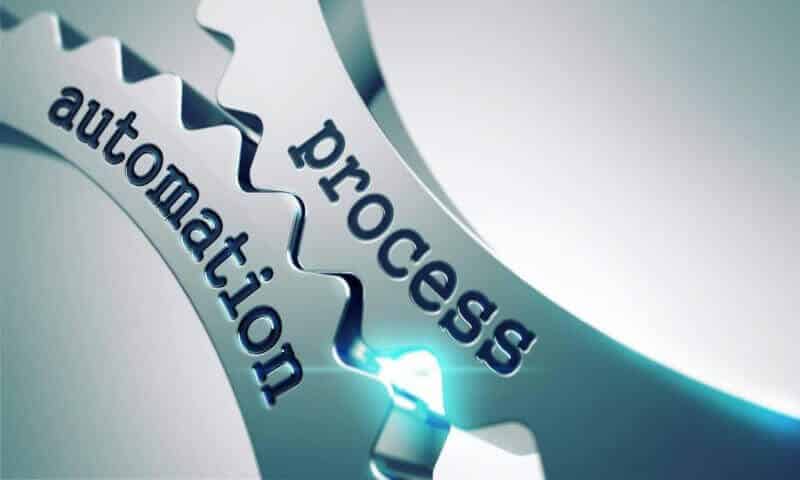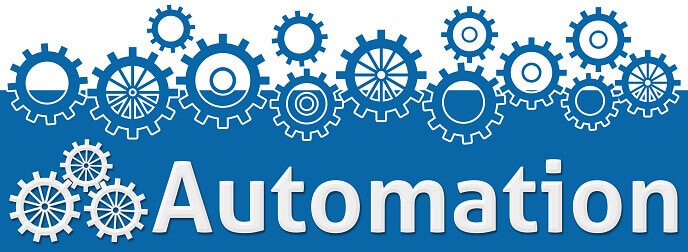 Enterprises currently spend over $1.5 billion to incorporate automation into their projects. Robotic automation is growing at a whopping rate of 60%. Fears that automation will kill more jobs continues to grow.
Enterprises currently spend over $1.5 billion to incorporate automation into their projects. Robotic automation is growing at a whopping rate of 60%. Fears that automation will kill more jobs continues to grow.
Now, the world is dealing not only with robots that do physical labor but with Artificial Intelligence that does mental labor as well.
What is Automation?

- It was first coined in 1948, in the manufacturing sense, by Ford Motors Vice President Delmar S. Harder.
- Automation or automatic control is about the usage of various control systems for the operation of equipment such as machinery, processes in factories, boilers, and heat treating ovens, switching on telephone networks, steering, and stabilization of ships, aircraft and other applications and vehicles with insignificant or reduced human involvement.
- In other words, it can also mean the use of computers to control a specific process in order to upturn consistency and efficacy thereby reducing human labor.
What is the Timeline of Automation?
Date |
Developments |
1500-1600 |
Water power for metalworking; rolling mills for coinage strips. |
1600-1700 |
Hand lathe for wood; mechanical calculator. |
1700-1800 |
Boring, turning, and screw cutting lathe, drill press |
1800-1900 |
Copying lathe, turret lathe, universal milling machine; advanced mechanical calculators. |
1808 |
Sheet-metal cards with punched holes for automatic control of weaving patterns in looms. |
1863 |
Automatic piano player (Pianola) |
1900-1920 |
Geared lathe; automatic screw machine; automatic bottle-making machine. |
1920 |
First use of the word robot |
1920-1940 |
Transfer machines; mass production. |
1940 |
First electronic computing machine. |
1943 |
First digital electronic computer. |
1945 |
The first use of the word automation. |
1947 |
The invention of the transistor. |
1952 |
First prototype numerical control machine tool. |
1954 |
Development of the symbolic language APT (Automatically Programmed Tool); adaptive control. |
1957 |
Commercially available NC machine tools. |
1959 |
Integrated circuits; first use of the term group technology |
1960 |
Industrial robots. |
1965 |
Large-scale integrated circuits |
1968 |
Programmable logic controllers |
1970s |
First integrated manufacturing system; spot welding of automobile bodies with robots; microprocessors; minicomputer-controlled robot; flexible manufacturing system; group technology. |
1980s |
Artificial intelligence; intelligent robots; smart sensors; untended manufacturing cells. |
1990-2000s |
Integrated manufacturing systems; intelligent and sensor-based machines; telecommunications and global manufacturing networks; fuzzy-logic devices; artificial neural networks; Internet tools; virtual environments; high-speed information systems |
2000-onwards |
4th Industrial Revolution, Internet of Things (IoT), Wearable devices, Personal and professional robots, Robotics from manufacturing to services and even the primary sectors of the economy, Big data. |
What are the major advantages of automation?
- It can replace hard physical and monotonous work such as daily routine works.
- It can be maintained and even upgraded by simple quality checks.
- Increased throughput time that is time to complete a job, therefore, increased productivity.
- Improved quality due to the replacement of humans by machines, therefore, reducing human induced errors.
- Improved reliability of processes and products by timely problem escalation and resolution if any the process or the product.
- Increased speed of production due to advancement in technology, therefore, better production time and thus higher output.
- Savings on the long-term costs of the labor and the cost of poor quality.
- Higher flexibility of skills as well as adaptation.
- In the jobs where there is a requirement of hard physical or monotonous work or dangerous environments (i.e. fire, space, volcanoes, nuclear facilities, underwater, etc.), robots can deliver better.
- Some tasks which are beyond human capabilities of size, weight, speed, endurance, such as lifting heavy machines, faster computing, weather perdition etc can be done be them efficiently.
- Open opportunities at the higher level in the development, deployment, maintenance and running of the automated processes.
What are the main disadvantages of automation?
- Security and vulnerability to hacking.
- The rise of unemployment across the manufacturing and services sectors and in the short term it would prove to be a huge challenge to the administration.
- Initial costs during the research and development may sometimes exceed the cost saved by automating the process.
- The initial capital requirement is very high and common people can’t afford it.
- The decrease in demand for human labor due to machines and intelligent robots taking over the jobs in the manufacturing and the services sectors. For example: In china, some customs officers are now robots, in Japan robots as housemaid is emerging trend.
- Automated technologies falling into the hands of the terror groups may unleash modern terror network including machine and therefore vulnerability of humans may magnify.
What are some applications of Automation in society?

Automation is playing many roles across the sectors to ease human life and make living conditions better. Some of its applications are:
- Manufacturing sector: Industrial robots have changed the game of production and now a single production line can produce multiple variants and therefore minimize the cost and optimize the timing of production.
- Health Sector: Automation of surgical instruments, health database and information on diseases of different types has led to the faster diagnosis and better drug prescription and further higher survival rates to the humans.
- Service sector: Robots are replacing to humans in the jobs across the restaurants, tourism, customs in the developed countries however it is still in nascent phase.
- Education: New kinds of tools which would be based upon the skill set and capability of the student can be developed. It can lead to education as per need, not as a directly forced medicine.
- Women and children: Automation can lead to the better surveillance system and therefore reduced crimes against them.
- Corruption: Automation in governance such as E-governance, in service delivery system such as E-sahyog may start an era of more transparent and good governance.
- Automated retail stores: Example – Macdonald keep robots as waiting manager, Bengaluru-based Pace Automation Ltd. has partnered with IBM to provide a cloud-based solution to help native Kirana merchants turn into e-tailers.
- Automated stores: Many supermarkets across the developed countries are going full automation to save costs.
- Automated Mining: We often hear the loss of human lives due to mining accidents. Therefore to reduce such instances people are being replaced by robots.
- Automated highway system: It’s very popular in western countries and recently our government has announced road safety policy on similar lines.
- Emerging trend is about Home automation using Internet of things where appliances are connected either by apps or by any local machine.
- Wearable devices: Next step of revolution is different kinds of devices which can monitor health 24*7*365 and even apply for medicines if required. Further, they will take care of other needs such as connectivity, exercise, education etc. Therefore all in one machine.
- Weather prediction: Natural calamities such as droughts, tsunami, floods, cyclones etc. can be predicted in advance and further early warning systems can help in reducing human and environmental loss.
- IT Automation: In judiciary may lead to faster resolution of cases and reduce justice delivery time.
- Automated patrolling: of border areas may strengthen our internal and border security and help in curbing cross-border terrorist infiltrations, human-animal-resource trafficking at the borders.
What are the new challenges emerging out of automation?

- Safety and security of data.
- As per a World Bank report, Automation looms threat on 69 percent of the jobs in India and 77 percent in China.
- As per reports by HR Honchos, 60% of the global workforce may get displaced in future by the automation and artificial
- The threat to privacy which is evident from the recent hacking of Debit cards.
- Regulation of these new technologies.
- The textile sector which used to employ 40 workers for an investment of 1 crore now employs only 25 workers per Rs.1 crore.(Texprocil and Ernest & Young report)
- Rising unemployment due to faster change of skills and technologies.
- Modern cyber criminals who remains invisible and cause pain to millions by direct or indirect criminality.
- It has become a tool for the terror group to spread their propaganda and attract young youths. For example social media such as Facebook, twitter has become hiring tool for them.
- A recent emerging threat is about the “Trust” on machines. Recent elections where EVMs were used led to some people speculating that they have been compromised. Therefore they may sometimes pose administrative challenges of this sort.
Paradox of Automation
The Paradox of Automation says that the more efficient the automated system, the more crucial the human contribution of the operators. Though the number of humans involved is less, their involvement becomes more critical. If an automated system has an error, it will multiply that error until it’s fixed or shut down. This is where human operators come in.
A fatal example of this was Air France Flight 447, where a failure of automation put the pilots into a manual situation they were not prepared for.
Conclusion
Many experts have described the rise of automation as one of the most important economic and social developments in history. The World Economic Forum (WEF) has characterized it as the fulcrum of a 4th Industrial Revolution. Moreover, the economist Andrew McAfee said, “Digital technologies are doing for human brainpower what the steam engine and related technologies did for human muscle power during the Industrial Revolution. They’re allowing us to overcome many limitations rapidly and to open up new frontiers with unprecedented speed. It’s a very big deal. But how exactly it will play out is uncertain.”
It may cause unemployment, unease in the mindset of masses, and even social conflict at many conflicts at many reasons. In the short run, it is very difficult to predict who will get the most of the benefits however better policy guidelines, better regulations, and social security measures will essentially bring overall goodness to the society.
Article by: Nishant Raj. The author is an IIT Kharagpur Alumnus.





Leave a Reply